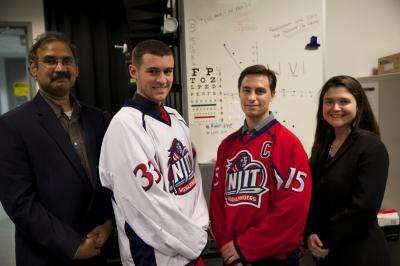Where hockey and engineering collide: NJIT Highlanders join a pioneering concussion study

Adam Finkle, a forward on the Highlanders club hockey team, will never forget the powerful collision that sent him hurtling to the ice in a hotly contested game against Seton Hall his junior year. What hit him harder still, however, was the slow-paced recovery.
Diagnosed with a concussion, he exited the game and the rest of the season on the orders of his doctor and hockey coach and spent the following weeks on the bench wrestling with a nagging question: how long would it take to fully recover? "With a leg or an arm break there is a usually a set amount of time in a cast, followed by physical therapy," he says. "But with a concussion, you can't always tell exactly when you'll be better."
Now a fifth-year architecture student and back on the ice, Finkle, and his hockey teammates will have the opportunity to help answer that question. Starting early next year, the Highlanders will take part in a pioneering study of traumatic brain injury led by two prominent biomedical engineers on the NJIT campus.
Backed by a grant from the National Science Foundation, Tara Alvarez, director of NJIT's Vision and Neural Engineering Laboratory, and Bharat Biswal, director of NJIT's Center for Brain Imaging, are building a machine that integrates two diagnostic devices - a near-infrared spectroscopy (NIRS) machine and a video-based eye tracking system - that together will allow them to see how changes in brain activity following an injury, including a mild concussion, correspond with changes in eye movements.
Strapped to the head, the NIRS machine uses light beams to measure blood oxygen levels - indicators of neural activity - in different regions of the brain. An ocular device Alvarez has created, known as a Vision and Neural Assessment Equipment (VNAE) system, measures eye movement, a promising biomarker for neurological functions such as visual attention and memory.
Novel technology, new insights
Working with the hockey team, Biswal and Alvarez will assess eye movements as well as other cognitive tasks with corresponding changes in brain blood flow to determine whether they can establish a reliable biomarker for concussions. Their ultimate goal is to create a portable medical device that can be carried to sports arenas to measure the severity of a brain injury on the spot and thus help the coach and the team doctor determine whether an athlete is at risk if sent back into the game. In war, the device would help a squad leader decide whether a soldier could return to battle.
Beginning in 2015, the research team will conduct NIRS tests of all participating hockey players to use as a baseline for comparison and will then follow up with concussion imaging of players who are injured in games, repeating the tests at regular intervals over the ensuing months.
Bob McMorrow, the Highlanders hockey coach, says he did not hesitate to take part in the study.
"Concussions are at the forefront of the injuries we're concerned about," he notes. "Those of us who coach contact sports do the best we can to keep our players safe, but there are freak injuries."
Key questions the researchers will explore, Alvarez says, are how concussions affect functions such as eye movement and hearing and whether these impacts depend on where people are hit on the head, how long they are unconscious, and if the effects are cumulative from injury to injury.
Antje Ihlefeld, an assistant professor of biomedical engineering who focuses on the way people hear sounds and how the brain processes auditory information, will collaborate. Previous studies have found that people with brain injuries can have difficulty identifying sounds in a noisy environment such as a crowded restaurant. Ihlefeld will assess which sounds are more distracting than others.
"By having several partners, we are able to look at so many different aspects of brain injuries, from functional connectivity (connections among regions of the brain), to vision, to hearing," says Alvarez. The NJIT team is also working with outside partners, including Mitchell Scheinman, O.D., of the Eye Institute in Philadelphia, to study children with brain injuries.
The study is also unusual for the amount of data on brain injury, spaced out over weeks and months, the researchers will collect.
Keeping closer tabs on injured athletes
"These tests are very expensive and clinicians can typically obtain a limited number of them. But since we'll have this technology on campus, our access will be unlimited, giving us more data points per second compared to function imaging," Biswal says. "One limitation of the NIRS technology is that it cannot give us information about brain areas located deep inside the brain. However, the instrumentation will allow us to assess vision, hearing, motor and many other executive functions such as decision making because these brain regions lie closer to the surface of the brain."
Richard LaBarbiera '18, a new defenseman on the team, said he has never been injured but is eager to participate in the study nonetheless.
"I'm all for it. Even if it doesn't directly help me, I hope it will help others," he says. "People don't always take these injuries seriously. But they should. Addressing them right away can prevent further injuries and possibly serious problems years later."















